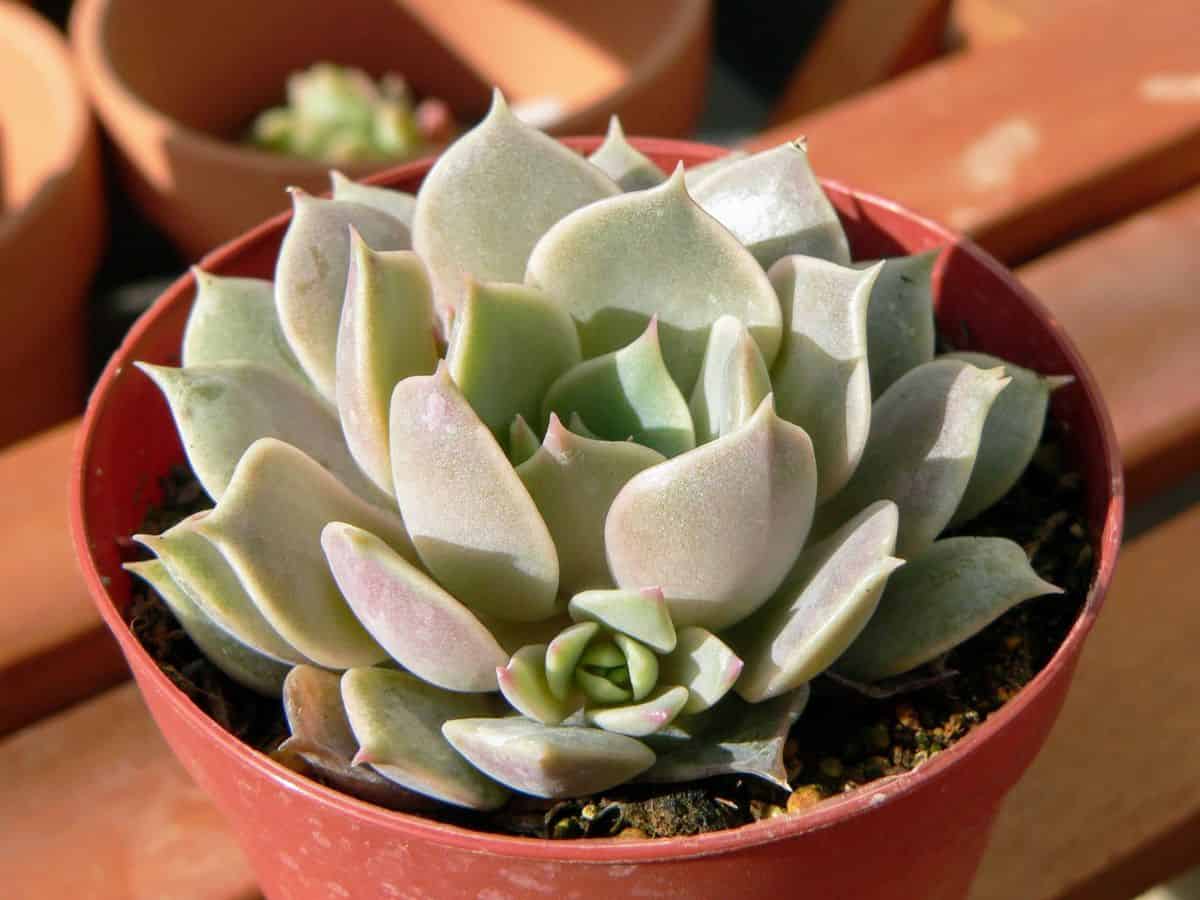The Echevieria lola is one of the most iconic Echeveria, this succulent radiates a pristine beauty that is impossible to miss.

Echevieria lola, or Mexican Hens and Chicks
| Name: | Echeveria lola |
| Soil: | Well-draining soil |
| Blooming: | Spring and early Summer |
| Light: | Bright light |
| Water: | When the soil is completely dry |
| Propagation: | Leaf and offsets |
You're not the first one to be entranced by the simple elegance of lola's coloration. The perfect symmetry, the soft yet eye-catching tones... this fat plant looks like a dream.
It is fortunate, then, that this plant is so common! The lola is often the plant that converts regular people into rabid succulent-lovers. So yes, you should get one.

Echeveria is known for its tight rosettes and propensity to grow close together. That's where their common name originates from! The mother plant (the hen) will grow little offshoots called pups or buds (the chicks).
No products found.
Eventually, the hen will be entirely surrounded by her children! This makes Echeveria an excellent choice for succulent arrangements.
They add much-needed depth and substance when acting as a base plant. Lola does not grow very large - usually less than 6 inches tall and 12 inches across. They're relatively durable little guys, you can keep them indoors or out.
Remember, though, that they are not frost-resistant. If the temperature starts to go below about 45 degrees Fahrenheit, you'll want to bring them inside. They do enjoy a bright, sunny day so grow them outside if the climate permits.
Little known fact: Eceheveria lola is actually a hybrid of two different Echeveria species and was created by a man named Dick Wright!
Echevieria lola Care

Say it with me folks: succulents need quick-draining soil. If you have questions about that, check out this article that discusses exactly that topic.
Plant it in a terracotta pot, but make sure it is not glazed. Glazed pottery retains water. Likewise, ensure the pot is on a saucer and that you remember to dump excess water from the saucer after watering. You don't want to let the plant sit in it.
Give your lola as much sunlight as you can! Bring it outside during the sunny months if possible, or put it on a south-facing windowsill. While the plant is hardy, it will not tolerate frost so bring it inside if the temperature drops too low.
Water your lola every week or every other week during the growing season (summer), depending on the heat and dryness of the air. During the dormant season (winter), water it much less frequently.
Ensure that the soil becomes completely dry between each watering. If you feel the need to fertilize (which should be rarely, maybe once a year), dilute the fertilizer to half strength and include it when you water.
Echevieria lola Propagation

Lucky you - the plant does all the work for you! Echeveria species are known colloquially as "hens and chicks" because they clone themselves into incredibly cute plant babies all the time!
These "chicks" often hug tight to the mother but can be removed and repotted whenever you like. You may have to untangle or clip a few roots, but usually, gentle tugging will get them to separate.
However, don't feel obligated to harvest the buds! Echevieria lola succulent does not mind being surrounded by its children!
You can also propagate via a leaf, although the process takes a while. Simply pull a leaf by pinching near the stem. You need a fully intact leaf for it to work.
Place the leaf on some dirt for a few days until it calluses. Then, water it frequently but sparingly, enough to keep the dirt moist.
You should find a tiny stem growing from that leaf within a couple of weeks!


Angie Sacdalan
Hi Patrick!
First of all, this is one of my favorite succulent sites to go to. I've just discovered this last week and I'm still not caught up on my reading 🙂
I currently have a 2" lola and I first placed it outdoor with a full sun/partial shade setting, East facing. It looked to me that it could use a bit of stress so I moved it to a South facing, full sunlight. The blushing is starting to come out but at the same time, it feels like it's also starting to get a sunburn. The tips are turning a slight brown and the bottom leaves are slightly wrinkling. I currently water this once a week. Is there a middle ground for this or am I missing something?
Thank you!
Angie
Patrick Grubbs
Hey Angie! Thanks for the compliment, it's very encouraging 🙂
All of your reasoning is totally on point, you've only missed one thing. Making the jump from partial sun to full sun can be traumatic - especially for more sensitive plants like Echeveria. To avoid that sunburn you need to acclimate the plant by slowly increasing the amount of sun it gets.
You can move it between windows every day (which is a hassle), or put it in the corner of the window where it'll get a little shade.
Unfortunately, sunburn isn't reversible. Once the plant grows a bit, though, you can pull off those burnt leaves and use them to propagate!!